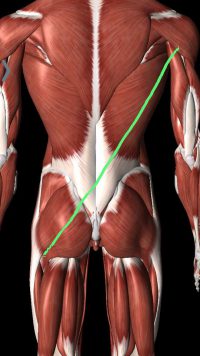 The picture shows a green line connecting the left Gluteus Maximus to the right Latissimus Dorsi muscle via the thoracolumbar fascia (white stuff). So if you have spasms or tension in either of these muscles it can create a problem. Equally if you have stiff or tight spinal joints it can create an imbalance in these muscles.
The picture shows a green line connecting the left Gluteus Maximus to the right Latissimus Dorsi muscle via the thoracolumbar fascia (white stuff). So if you have spasms or tension in either of these muscles it can create a problem. Equally if you have stiff or tight spinal joints it can create an imbalance in these muscles.
Why… do I need to know about these muscles I hear you say…..well……that muscular sling or ‘Back Functional Line’ as it is known is incredibly important for everyday tasks. When it works properly it help to extend your hip joint on the left and the shoulder on the right which is pretty important for walking/running movements. Not only does it create movement but it also creates stability, as it causes force closure of the sacroiliac joints and tenses the thoracolumbar fascia (white stuff) to better support the low back.
Any athletes out there will know the dangers of deadlifting with a rounded back, well that is caused by misfiring of either the Latissimus Dorsi or the Gluteus Maximus. With tennis or any throwing sports the power is generated largely in the ‘wind up’ phase. In this case, a right forehand shot or right arm throw where the right shoulder is pulled back. Do you know how that is done? You guessed it, via the action of these muscles.
So how could you develop a problem with these muscles? An all too common way we see in the clinic is through sitting. When the shoulders round off and roll forwards it lengthens this sling system and weakens it. Remember we are not made for sitting! A tutor of mine once used the phrase ‘Motion is the lotion for your joints’ and that is true for the muscles as well.
This is one way low back pain and shoulder pain can be connected but remember don’t guess, get assessed.

